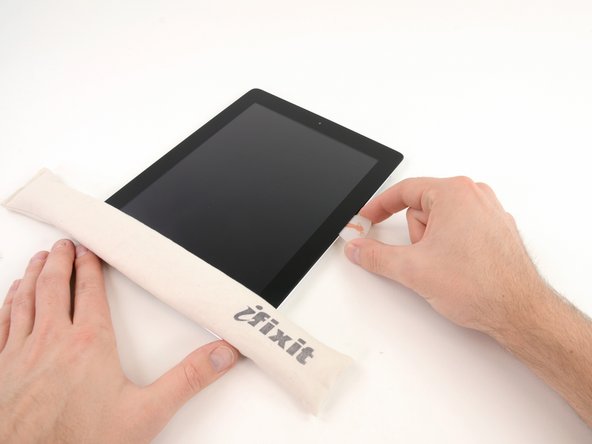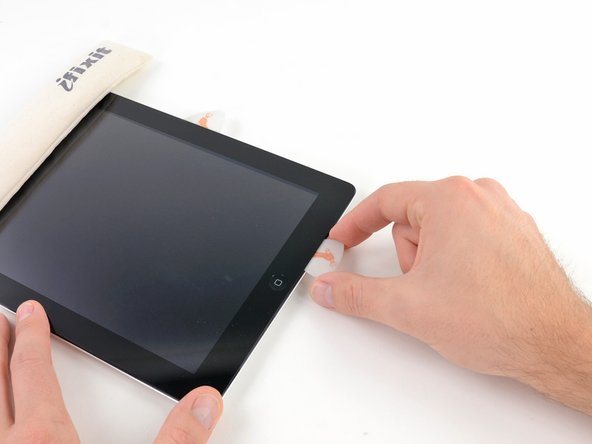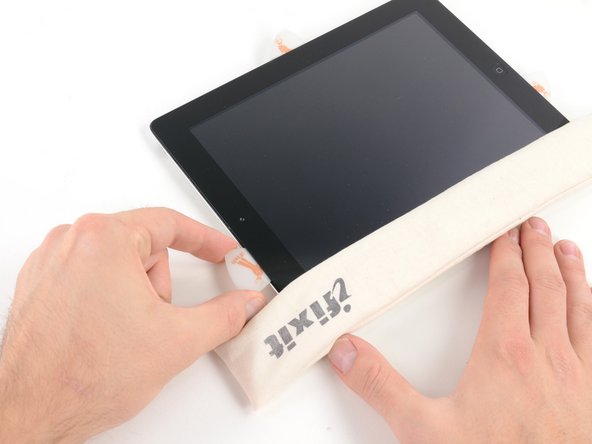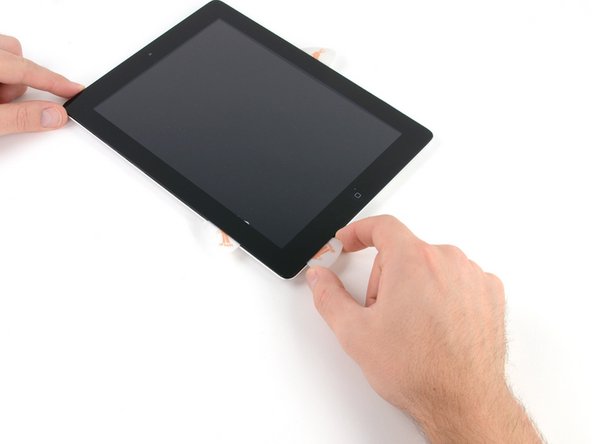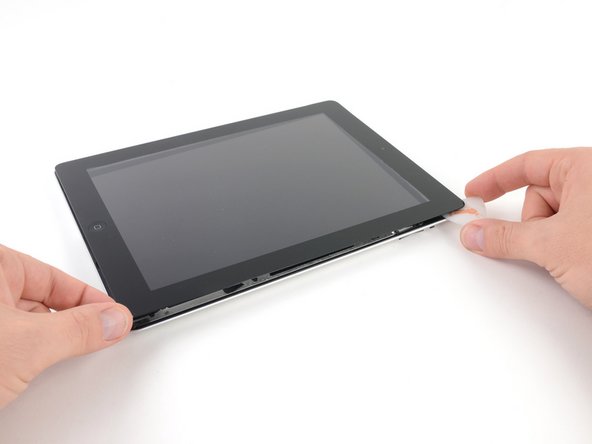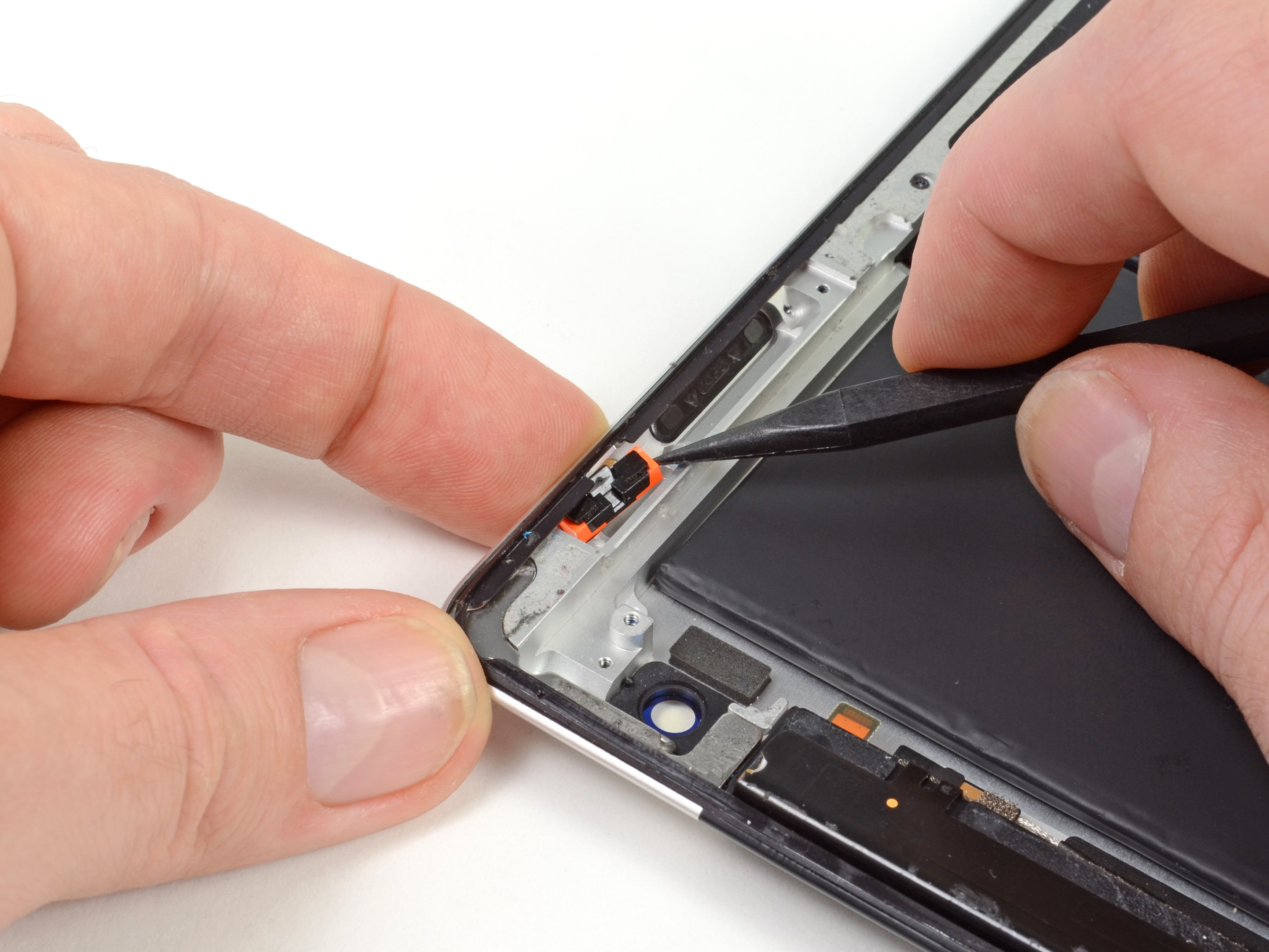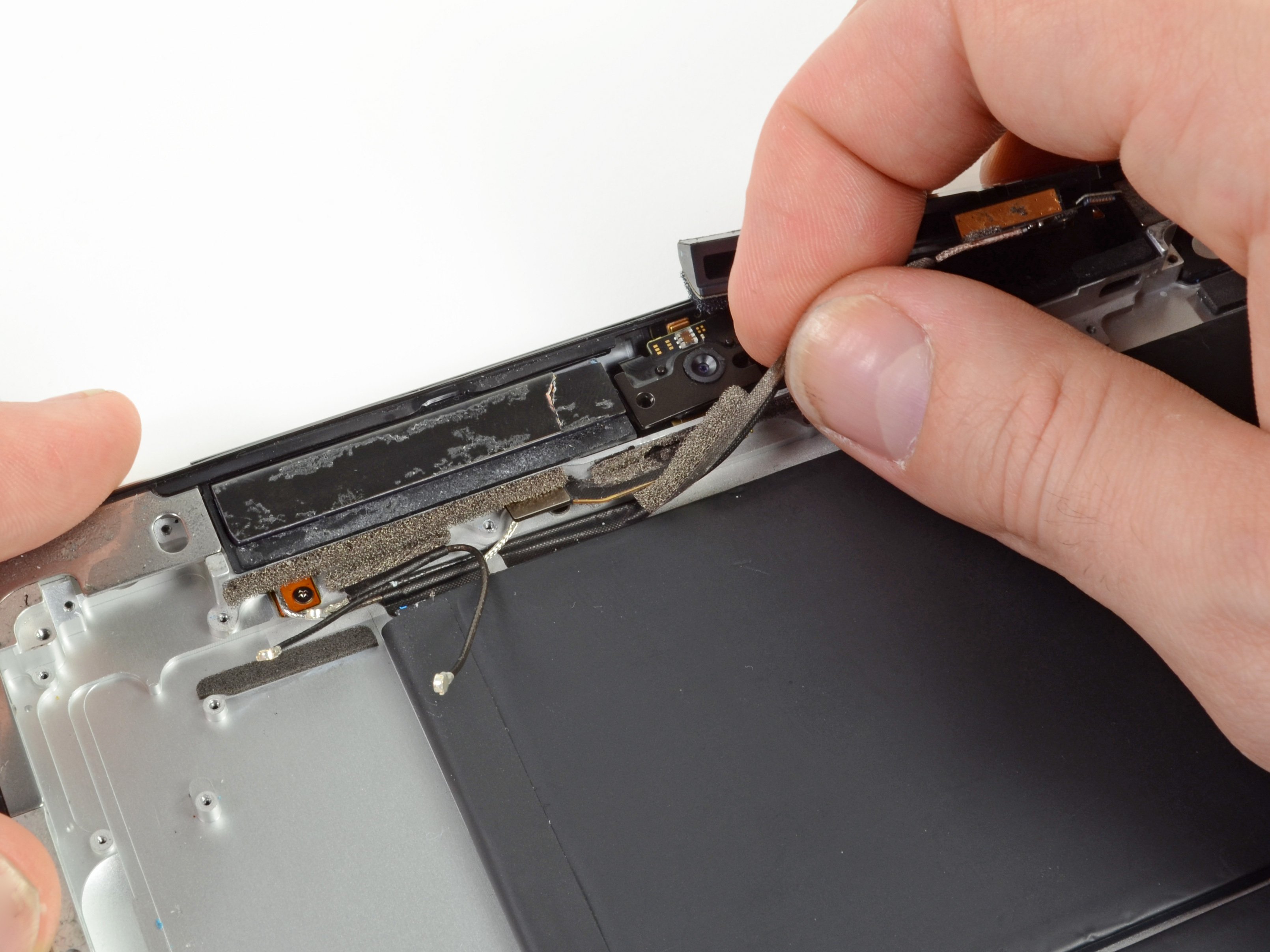iPad 3 4G SIM Board Replacement
Duration: 45 minutes
Steps: 41 Steps
A broken SIM board is like having no keys to the fast lane of 4G connectivity. Instead of sticking to the slow Wi-Fi side streets, follow this guide to swap out the SIM board in your third generation iPad 4G and get back on the information expressway.
Step 1
For carousel microwaves: Ensure the plate is spinning like a dancer! If your iOpener gets a little stuck, it might overheat and cause some drama. Keep it moving for a smooth ride!
Before diving into this repair, it's a great idea to give your microwave a quick clean. Trust us, you don't want any pesky residue getting cozy on the iOpener.
- Pop that iOpener right in the middle of the microwave and let it soak up the warmth!
Tools Used
Step 2
Keep an eye on your iOpener’s temperature—overheating it might just make it pop like a balloon! Don’t heat it past 100˚C (212˚F).
If your iOpener looks puffed up or swollen, do NOT touch it. Safety first!
If it’s still too toasty in the middle to handle, keep using it gently while it cools down a bit before giving it another warm-up. When heated just right, your iOpener will stay nice and warm for about 10 minutes.
Depending on how powerful your microwave is, you might need to adjust the time a bit. The iOpener is ready when it’s just too hot to handle comfortably. Keep an eye on it, and you’ll be good to go!
- Warm up the iOpener in the microwave for about thirty seconds to get it ready.
- If it cools down during your repair, just pop it back in the microwave for another thirty seconds to keep things toasty.
Tools Used
Step 3
The iOpener gets pretty hot, so handle it with care! If you want to keep your hands safe, an oven mitt will do the trick.
- Carefully take the iOpener out of the microwave, grabbing it by one of the flat ends so you don’t touch the hot center.
Tools Used
Step 4
Heads up! That iOpener gets seriously hot, so make sure to grab it only by the little end tabs to keep your fingers safe and sound.
No microwave? No worries! Just pop your iOpener in a pot of boiling water to heat it up.
- Grab a pot or pan and fill it with enough water to completely submerge your iOpener.
- Bring the water to a boil, then turn off the heat.
- Drop your iOpener into the hot water for 2-3 minutes. Make sure it's fully submerged.
- Use some tongs to carefully pull the iOpener out of the water.
- Dry it off well with a towel.
- All set! If you need to reheat the iOpener, just bring the water back to a boil, turn off the heat, and let it sit in the water for 2-3 minutes again. Easy, right?
Tools Used
Step 5
- Grab a SIM eject tool or a straightened paperclip and gently pop out the SIM tray.
Step 6
- Gently pull the SIM tray out from its slot and take it out of your iPad.
- If you’re swapping the SIM card, pop the old one out of the tray and slide the new card in.
Step 7
Pop on those safety glasses to keep your eyes safe, and remember, the LCD screen is delicate—handle it with care!
This keeps those sneaky glass shards in check and gives you the grip you need when prying and lifting the display.
- If your display glass has a crack, let's keep it from turning into a full-blown disaster! Grab some tape and secure that glass to prevent any further mishaps and keep your fingers safe during the repair.
- Now, let’s get that iPad looking all good again! Lay down some overlapping strips of clear packing tape over the display until the entire front is covered. It's like giving your iPad a protective blanket!
- Keep your eyes on the prize and follow the rest of the guide step by step. Just a heads up, when the glass is broken, it might keep cracking as you go. You might need to use a metal prying tool to carefully scoop out the glass pieces, but you've got this!
Step 8
Hey there! Just a friendly reminder: while you're getting into the nitty-gritty of this repair, you might encounter some tricky broken glass. So, do yourself a solid and rock a pair of safety glasses to keep those pesky shards at bay!
- Place the iOpener flat on the right edge of your iPad. Smooth it out gently to make sure it's making solid contact with the surface of the iPad.
- Let the iOpener sit there for about 90 seconds. This gives it time to warm up the front panel before you get started with opening it.
Tools Used
Step 9
Getting that stubborn tip of the opening tool between the glass and plastic might take a little muscle! Just take your time and be gentle; wiggle that plastic opening tool back and forth as needed, and you'll be on your way to success.
- Check it out! There’s a tiny little gap in the iPad's adhesive ring, right up in the upper right corner. It’s about 2.0 inches (or ~5 cm) from the top. Let's take advantage of this little flaw!
- Now, line up your tool with the mute button. Gently insert the tip of a plastic opening tool into that gap between the front glass and the plastic bezel. Just slide in the very tip—just enough to pop that crack open a bit!
Step 10
- Carefully tuck the tool right between the plastic display bezel and the front glass panel—like sliding into your favorite spot on the couch!
Step 11
- Hold the tip of your plastic opening tool snugly between the front glass and plastic bezel, then slide a plastic opening pick right into that gap, right next to your opening tool. Smooth moves!
Step 12
- Slide the plastic opening tool out of the iPad, then gently nudge the opening pick further beneath the front glass about half an inch deep. Keep it smooth and steady!
Step 13
- As you're carefully peeling off the adhesive on the right side of your iPad, pop your iOpener back in the microwave for a quick reheating session. Then, place it along the bottom edge of your iPad to keep things nice and warm while you work.
Tools Used
Step 14
- While the iOpener is working its magic on the bottom edge, start peeling back the adhesive from the right edge of your iPad.
- Carefully slide the opening pick down the edge of the iPad, releasing that stubborn adhesive as you go.
The adhesive is pretty strong, so you might need to apply some serious effort. Take it slow and steady, and you'll get there!
If you spot the tip of your opening pick peeking under the front glass, give it a gentle pull out. Don't worry, going this deep won't cause any harm, but be aware it might leave some adhesive residue on the LCD. A little mess, but nothing we can't clean up later!
Tools Used
Step 15
You might need to slide that warm iOpener back over to the right edge of your iPad as you peel away the adhesive. How long it's been since your iPad had a cool-down session will affect this, so keep an eye on it while you work your magic.
- If the opening pick gets a little stuck in the adhesive, just give it a gentle roll along the side of the iPad. Keep it moving to slowly release that stubborn adhesive. Patience is key!
Tools Used
Step 16
- Before pulling out the first opening pick from the bottom corner of the iPad, slide a second pick under the right side of the front glass to keep that sticky adhesive from sticking back together.
- Warm up the iOpener again, then move it over to the top edge of the iPad to get things nice and toasty.
Tools Used
Step 17
Hey there! Just a friendly heads-up: the Wi-Fi antenna is snugly fastened to the bottom right edge of the rear case of your iPad with screws and a cable. Since it's positioned in a specific way, let's be super careful while working on it – we wouldn't want to accidentally cause any irreversible damage to the Wi-Fi antenna. You've got this!
- Heads up! The next steps need a steady hand and some serious care.
- You’ll be peeling off the adhesive holding the antenna to the front panel, but watch out for the fragile connections linking the antenna to the bottom of the iPad. Take it slow and follow along carefully.
Step 18
Keep the pick from sliding past the bottom right corner—going further might give the Wi-Fi antenna a little unwanted love tap.
- Gently work the opening pick around the lower right corner of the iPad to free up that sticky adhesive. You're doing great!
Step 19
Take your time moving the opening pick along the bottom right edge of the front panel. The Wi-Fi antenna is tucked in close to the corner, and if you’re not careful, it could get damaged if the adhesive is disturbed too quickly. A little patience here goes a long way!
Keep the pick tucked just a smidge under the front glass—don't yank it all the way out. Aim to leave about 1/8" (3 mm) of the tip still chilling underneath.
- Gently slide the opening pick along the bottom edge of your iPad, loosening the adhesive that holds the Wi-Fi antenna in place. Take your time—patience is key here.
Step 20
- Once you've navigated past the Wi-Fi antenna (about 3 inches from the right edge, right by the home button), reinsert that trusty opening pick all the way in.
- Now, give that pick a gentle slide to the right to break free the adhesive that's been holding the Wi-Fi antenna snug against the front glass.
- Remember, the antenna is bolted down to the bottom of the iPad with screws and a cable. This step is crucial because it frees the antenna from the front panel, so when you go to lift off the panel, your antenna stays safe and sound.
Step 21
- Keep on peeling away that adhesive at the bottom of the iPad! Gently pull the opening pick out just enough to smoothly glide around the home button, and then pop it back in about 1/2 inch (10 mm) deep once you’ve maneuvered past the home button. You've got this!
Keep the iOpener in check! Heat it for no more than a minute at a time, and give it a solid two-minute break before you reheat it. Patience is key!
If the adhesive has cooled down too much along the bottom edge, simply reheat the iOpener and give that area a little warmth before you get back to work. It’ll help soften things up and keep the process smooth.
Tools Used
Step 22
On iPad 4 models, gently slide the pick into this area, but stop once it's about 1/2 inch (10 mm) deep. You want to avoid messing with that home button ribbon cable!
- Keep peeling back that sticky stuff all the way across the bottom edge of the iPad. You're doing great!
- Make sure to leave the opening pick snugly tucked under the front glass near the home button. It's like giving it a little hug!
Step 23
- Pop that iOpener in the microwave for a little warmth party, then place it on the left edge of the iPad. This will help get the adhesive in that area all cozy and ready to come off.
Tools Used
Step 24
If your adhesive has chilled out a bit too much, just pop the iOpener back on the top edge and keep at it. And hey, if the iOpener itself is feeling a little cold, give it a quick warm-up to get things moving again.
- Gently glide the opening pick along the top edge of your iPad, giving it a little nudge to wiggle around that pesky front-facing camera bracket.
- The adhesive in this area is pretty thick, so don’t hesitate to apply some good ol' elbow grease. Just take it slow and steady—nobody wants a slip-up that could harm you or your iPad.
- If the opening pick starts to feel like it's stuck in the adhesive, try 'rolling' the pick as demonstrated in step 9.
Tools Used
Step 25
If the adhesive has warmed up nicely, go ahead and take the iOpener off the iPad for some ease of movement. But if it's still feeling a bit too sticky, give the iOpener another heat-up session and place it on the left edge while you work your magic.
- Keep gently peeling the adhesive along the top edge of your iPad, and carefully slide the opening pick around the top left corner. Take it slow, and you'll be cruising through this in no time.
Tools Used
Step 26
The digitizer cable hangs out about 2" (50 mm) up from the bottom of your iPad. When sliding your pick under, ease off once you hit roughly 2.25" (60 mm) from the bottom to keep things safe and sound.
- Gently slide the opening pick along the left edge of the iPad to loosen the adhesive as you go. The adhesive is extra thin here because of the digitizer running along the entire left side. Keep the pick shallow—no deeper than about 10 mm (half an inch)—to avoid any accidental damage to the digitizer.
Step 27
Heads up! The bottom of the digitizer cable is just about 1 inch (25 mm) from the iPad's bottom edge. Take it slow and steady to avoid accidentally snipping this little guy.
- Slide the opening pick gently along the bottom edge of the iPad, and carefully loosen the adhesive at the bottom left corner.
Step 28
Sometimes the adhesive around the iPad’s edge likes to play sticky and reattach itself. If that happens, gently slide a pick under the edge where the glass is still holding tight and carefully "cut" through the adhesive to free it up.
- Grab one of those nifty opening picks and gently lift up the bottom right corner of your iPad. Once it's popped, go ahead and use your fingers to hold it in place like a pro.
Step 29
Watch out for any sticky adhesive still hanging around, and gently use an opening pick to slice through any glue keeping that front panel stuck.
- Grab your iPad by the top and bottom right corners and gently pivot the front glass away from the device. You've got this!
- When putting everything back together, take a moment to use a microfiber cloth and some compressed air to wipe away any pesky dust or fingerprints from the LCD before you set the glass back in place. A clean screen is a happy screen!
Step 30
- Unscrew the four tiny 2 mm Phillips #00 screws holding the LCD onto the aluminum frame—time to loosen those little guys!
Step 31
Handle the LCD with care! That ribbon cable is like a delicate flower – too much bending and it might just wilt away.
- Grab your trusty plastic opening tool or spudger and gently lift the right edge of the LCD away from the iPad. You're doing great!
- Once it's free, swing that LCD around along its left edge and let it rest comfortably on the front panel. Nice and easy!
Tools Used
Step 32
- Grab your trusty spudger and gently lift that tape off the LCD ribbon cable connector like you're unwrapping a present. Easy peasy!
Tools Used
Step 33
- Lift the retaining flap on the LCD ribbon cable ZIF connector with a gentle flick of your fingers.
- Using your trusty fingers or a pair of tweezers, carefully slide the LCD ribbon cable out of its cozy socket on the logic board.
- If your LCD screen decides to play hard to get and doesn't light up after reconnecting the ZIF connector, give your iPad a quick restart by holding down the power and home buttons together for at least ten seconds until you see the Apple logo pop up. You've got this!
Step 34
- Carefully lift the LCD away from the front panel without touching its surface.
Step 35
- Grab your trusty spudger and gently peel back the tape that holds the touchscreen ribbon cable snug against the logic board. You've got this!
Tools Used
Step 36
- Gently lift the retaining flap on both of those sleek touchscreen ribbon cable ZIF connectors. You've got this!
Step 37
- Gently slide the flat end of your spudger under the digitizer ribbon cable to break up the sticky adhesive holding it down.
- Carefully pull the digitizer ribbon cable straight out from its connectors on the logic board—no sideways wiggles!
Tools Used
Step 38
- Gently lift the touchscreen ribbon cable and grab your trusty spudger to carefully loosen the adhesive holding that cable tight against the rear aluminum case. You've got this!
Tools Used
Step 39
- Gently use your fingers to wiggle the touchscreen ribbon cable free from its snug spot in the aluminum frame.
- Carefully lift the front panel off the iPad and set it aside.
Step 40
- Unscrew those three 1.75 mm Phillips #00 screws that are holding the SIM board snugly against the aluminum frame.
Step 41
Gently move the headphone jack assembly cable aside—pulling too hard might just rip that jack right off, and nobody wants that!
- To put your device back together, just follow these steps in reverse and you’ll be all set! If you hit a snag, remember you can always schedule a repair with us.




























